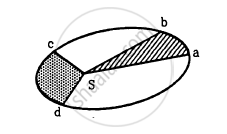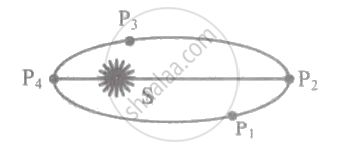Advertisements
Advertisements
Questions
Observe the given figure showing the orbit of a planet moving around the Sun and write the three laws related to it:

The orbit of a planet moving around the Sun
State the laws related to the given diagram:

Solution
- Kepler’s first law: The orbit of a planet is an ellipse with the sun at one of the foci.
- Kepler’s second law: The line joining the planet and the sun sweeps equal areas in equal intervals of time.
- Kepler’s third law: The square of the orbital period of revolution of a planet around the Sun is directly proportional to the cube of the mean distance of the planet from the Sun.
APPEARS IN
RELATED QUESTIONS
A Saturn year is 29.5 times the earth year. How far is the Saturn from the sun if the earth is 1.50 ×108 km away from the sun?
In the Following figure shows the elliptical path of a planet about the sun. The two shaded parts have equal area. If t1 and t2 be the time taken by the planet to go from a to b and from c to d respectively,

Answer the following question.
State Kepler’s law of equal areas.
Answer the following question.
State Kepler’s law of the period.
The orbit of a planet revolving around a star is _______.
The square of its period of revolution around the sun is directly proportional to the _______ of the mean distance of a planet from the sun.
Write the Kepler's laws.
A planet is revolving around the sun in an elliptical orbit as shown in figure. At which point will its K.E. be maximum?

The mass and radius of earth is 'Me' and 'Re' respectively and that of moon is 'Mm' and 'Rm' respectively. The distance between the centre of the earth and that of moon is 'D'. The minimum speed required for a body (mass 'm') to project from a point midway between their centres to escape to infinity is ______.
A planet revolves in an elliptical orbit around the sun. The semi-major and minor axes are a and b, then the time period is given by:
Both earth and moon are subject to the gravitational force of the sun. As observed from the sun, the orbit of the moon ______.
If the sun and the planets carried huge amounts of opposite charges ______.
- all three of Kepler’s laws would still be valid.
- only the third law will be valid.
- the second law will not change.
- the first law will still be valid.
Supposing Newton’s law of gravitation for gravitation forces F1 and F2 between two masses m1 and m2 at positions r1 and r2 read F1 = – F2 = `- r_12/r_12^3 GM_0^2 ((m_1m_2)/M_0^2)^n` where M0 is a constant of dimension of mass r12 = r1 – r2 and n is a number. in such a case.
- the acceleration due to gravity on earth will be different for different objects.
- none of the three laws of Kepler will be valid.
- only the third law will become invalid.
- for n negative, an object lighter than water will sink in water.
Draw areal velocity versus time graph for mars.
What is the direction of areal velocity of the earth around the sun?
A star like the sun has several bodies moving around it at different distances. Consider that all of them are moving in circular orbits. Let r be the distance of the body from the centre of the star and let its linear velocity be v, angular velocity ω, kinetic energy K, gravitational potential energy U, total energy E and angular momentum l. As the radius r of the orbit increases, determine which of the above quantities increase and which ones decrease.
Earth’s orbit is an ellipse with eccentricity 0.0167. Thus, earth’s distance from the sun and speed as it moves around the sun varies from day to day. This means that the length of the solar day is not constant through the year. Assume that earth’s spin axis is normal to its orbital plane and find out the length of the shortest and the longest day. A day should be taken from noon to noon. Does this explain variation of length of the day during the year?
Halley's Comet revolves around the sun for a time period of 76 years. The aphelion distance if perihelion is given by 8.9 × 1010 m, will be ______.
(Take, the mass of sun = 2 × 1030 kg and G = 6.67 × 10-11 Nm3/kg2)
